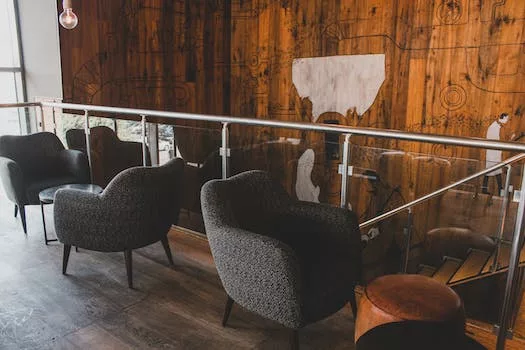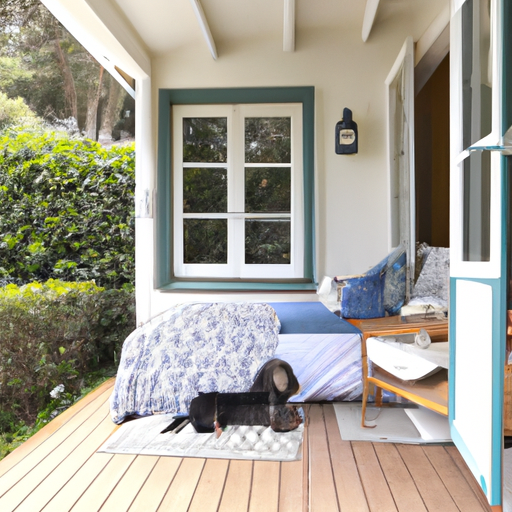Designing Pet-Friendly Spaces: Key Architectural Elements for a Happy Home
The role of architecture in creating a home that’s perfect for pets is often overlooked, but it is an essential aspect of designing a space that is both functional and comfortable for all inhabitants. As more and more people consider their pets as integral members of the family, it is important to take their needs into account when designing a home. This article will explore the key architectural elements that contribute to a pet-friendly space, ensuring a happy home for both humans and their furry companions.
One of the most important aspects of designing a pet-friendly home is to consider the layout and flow of the space. This includes creating open floor plans that allow pets to move freely throughout the home, as well as providing designated areas for them to eat, sleep, and play. Open floor plans not only make it easier for pets to navigate the space, but they also promote social interaction between pets and their owners. This can be particularly beneficial for pets that suffer from separation anxiety, as they will be able to see and interact with their owners more easily.
In addition to open floor plans, it is important to consider the materials used in the construction of the home. Pets can be hard on flooring, so it is essential to choose materials that are durable and easy to clean. Hardwood floors, for example, are a popular choice for pet owners because they are easy to maintain and can withstand the wear and tear of pets’ nails. However, it is important to choose a hardwood with a high Janka hardness rating, as softer woods can be more susceptible to scratches and damage. Alternatively, tile and laminate flooring are also good options for pet-friendly homes, as they are both durable and easy to clean.
Another key architectural element to consider when designing a pet-friendly home is the inclusion of pet-specific features. This can include built-in feeding stations, pet doors, and even designated pet-washing areas. These features not only make life easier for pet owners, but they also help to create a space that is specifically tailored to the needs of the pets themselves. For example, a built-in feeding station can help to keep pet food and water bowls organized and off the floor, while a pet door allows pets to come and go as they please, promoting independence and reducing the risk of accidents inside the home.
Lighting is another important aspect of designing a pet-friendly space. Pets, like humans, are sensitive to their environment and can be affected by the quality of light in their living space. Natural light is always the best option, as it provides a more comfortable and inviting atmosphere for both pets and their owners. Large windows and skylights can help to maximize the amount of natural light in the home, while also providing pets with a view of the outdoors, which can be both stimulating and comforting.
Finally, it is important to consider the outdoor spaces of the home when designing a pet-friendly environment. A well-designed backyard or outdoor area can provide pets with a safe and secure space to play, exercise, and explore. This can include features such as secure fencing, designated play areas, and even pet-friendly landscaping, such as the use of non-toxic plants and materials.
In conclusion, the role of architecture in creating a home that is perfect for pets is multifaceted and involves careful consideration of various elements, including layout, materials, pet-specific features, lighting, and outdoor spaces. By taking these factors into account, homeowners can create a space that is not only functional and comfortable for their pets but also promotes a happy and harmonious living environment for all members of the family.
Integrating Pet Amenities: Innovative Architectural Solutions for Modern Homes

The role of architecture in creating a home that’s perfect for pets is an increasingly important consideration for homeowners and designers alike. As our furry friends become more and more integrated into our daily lives, it’s essential to consider their needs and preferences when designing and building our living spaces. This not only ensures the comfort and well-being of our pets but also contributes to a harmonious and functional home environment for all its inhabitants. In this article, we will explore some innovative architectural solutions that can help create a modern home that caters to the needs of both humans and their beloved pets.
One of the key aspects of integrating pet amenities into a home’s design is to consider the specific needs and habits of the animals that will be living there. For example, cats are known for their love of climbing and perching in high places, while dogs often require ample space to run and play. By incorporating features such as built-in climbing shelves, catwalks, or even a dedicated pet room, architects can create spaces that cater to these natural instincts and provide a stimulating environment for pets to explore and enjoy.
Another important factor to consider is the durability and ease of maintenance of the materials used in the home. Pets can be messy, and accidents are bound to happen, so it’s crucial to choose materials that can withstand the wear and tear of daily life with pets. Hardwood floors, for example, can be easily scratched by pet claws, while carpeting can trap pet hair and odors. Instead, consider using materials such as polished concrete, tile, or laminate flooring, which are more resistant to damage and easier to clean. Similarly, opt for furniture and upholstery made from materials that are resistant to stains and can be easily wiped clean.
In addition to considering the needs of pets, it’s also essential to think about the impact that pet-friendly design can have on the overall aesthetic and functionality of the home. Integrating pet amenities into the architecture of a home doesn’t have to mean sacrificing style or sophistication. In fact, many modern pet-friendly design elements can be seamlessly incorporated into the overall design of the home, creating a space that is both stylish and functional for all its inhabitants.
For example, built-in feeding stations can be incorporated into the design of a kitchen island or cabinetry, providing a convenient and discreet place for pets to eat without disrupting the flow of the space. Similarly, custom-designed pet doors can be integrated into the architecture of the home, allowing pets to move freely between indoor and outdoor spaces without compromising the home’s security or energy efficiency.
Another innovative architectural solution for pet-friendly homes is the incorporation of “pet zones” within the living space. These designated areas can be designed to accommodate pet beds, toys, and other essentials, providing a dedicated space for pets to relax and play without encroaching on the main living areas of the home. This not only helps to maintain a clean and organized living environment but also allows pets to feel more secure and comfortable in their own designated space.
In conclusion, the role of architecture in creating a home that’s perfect for pets is an essential consideration for modern homeowners and designers. By integrating pet amenities into the design and layout of a home, architects can create spaces that cater to the needs of both humans and their furry friends, ensuring a harmonious and functional living environment for all. With innovative solutions such as built-in climbing shelves, pet-friendly materials, and designated pet zones, it’s possible to create a stylish and sophisticated home that meets the needs of all its inhabitants, both two-legged and four-legged alike.
Balancing Aesthetics and Functionality: Creating a Stylish and Pet-Friendly Home
The role of architecture in creating a home that’s perfect for pets is a delicate balance between aesthetics and functionality. As pet owners, we want our homes to be stylish and visually appealing, but we also need them to be practical and accommodating for our furry friends. This balance can be achieved through thoughtful design and careful consideration of the needs of both the homeowner and their pets.
One of the primary concerns when designing a pet-friendly home is ensuring that the space is safe and comfortable for the animals. This means taking into account their size, habits, and preferences. For example, a home with a large dog may require more open floor space for the animal to move around comfortably, while a home with a cat may benefit from built-in perches and climbing structures. Additionally, pet owners should consider the materials used in the home’s construction, as some may be more durable and easier to clean than others. For instance, hardwood floors are often a better choice than carpeting, as they are less likely to harbor allergens and can be easily wiped clean.
Another important aspect of creating a pet-friendly home is ensuring that the space is adaptable to the changing needs of the animals. This may mean incorporating features that can be easily modified or removed as the pet grows or their needs change. For example, a dog owner may choose to install a removable dog door that can be easily taken out if the pet is no longer able to use it. Similarly, a cat owner may opt for modular cat furniture that can be rearranged or added to as the cat’s preferences change.
In addition to considering the needs of the pets, it is also essential to think about the aesthetic preferences of the homeowner. A pet-friendly home does not have to sacrifice style for functionality. In fact, many design elements that are beneficial for pets can also be visually appealing. For example, built-in pet feeding stations can be both practical and stylish, seamlessly blending into the home’s design. Similarly, pet-friendly furniture, such as washable slipcovers and stain-resistant fabrics, can be both functional and fashionable.
One of the keys to achieving a balance between aesthetics and functionality in a pet-friendly home is to consider the needs of the pets and the homeowner from the very beginning of the design process. By working with an architect or designer who understands the unique requirements of a pet-friendly space, homeowners can ensure that their home is both beautiful and accommodating for their furry friends.
In conclusion, the role of architecture in creating a home that’s perfect for pets is to strike a balance between aesthetics and functionality. This can be achieved by considering the needs of both the homeowner and their pets, incorporating adaptable and durable design elements, and working with professionals who understand the unique challenges of designing a pet-friendly space. By doing so, pet owners can create a home that is not only visually appealing but also comfortable and safe for their beloved animals.
Q&A
Question 1: How does architecture contribute to creating a pet-friendly home?
Answer 1: Architecture plays a significant role in designing a pet-friendly home by incorporating elements such as open floor plans, durable materials, and pet-specific spaces that cater to the needs and comfort of pets while ensuring the home remains functional and aesthetically pleasing for the owners.
Question 2: What are some architectural features that can be included in a home to make it more suitable for pets?
Answer 2: Some architectural features that can be included in a pet-friendly home are pet nooks or designated spaces, easy-to-clean flooring materials, built-in feeding stations, pet doors for easy access to outdoor areas, and strategically placed windows or perches for pets to observe their surroundings.
Question 3: How can architects balance the needs of both homeowners and their pets when designing a home?
Answer 3: Architects can balance the needs of homeowners and their pets by considering the lifestyle and preferences of the owners, the size and breed of the pets, and the overall aesthetics of the home. This involves creating spaces that are both functional and visually appealing, using materials that are durable and easy to maintain, and incorporating pet-friendly features that seamlessly blend with the overall design of the home.
Conclusion
In conclusion, the role of architecture in creating a home that’s perfect for pets is significant as it involves designing spaces that cater to the specific needs and behaviors of pets, ensuring their safety, comfort, and well-being. By incorporating pet-friendly materials, layouts, and features, architects can create a harmonious living environment that benefits both the pets and their owners, ultimately enhancing the overall quality of life for all inhabitants.


